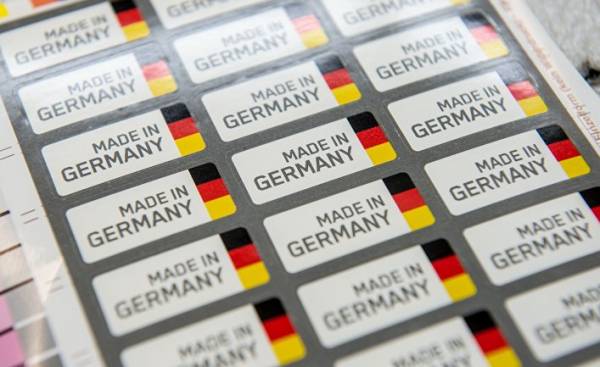
In 2016, the United States became the largest market for German exporters. The total value of goods Germany sold overseas amounted to 107 billion euros. While German exports to America in money terms to € 49 billion exceeded the amount of goods that Germany imported from the United States. This situation has caused outrage of the American President Donald trump, who called the behavior of the Germans “unfair”. But is it unfair if you consider the reputation enjoyed by the world’s goods “Made in Germany”?
Products from Germany — synonymous with quality
According to the results of a study conducted by the Berlin firm Dalia Research commissioned by statistics portal Statista, “Made in Germany” ahead of other brands in popularity among consumers. As the authors of the study, for many buyers, this brand created in the late nineteenth century by the British, who wanted to protect consumers from the influx of cheap imports and fake products from Germany, remains synonymous with advanced technology, quality and high safety standards.
To find out, sociologists interviewed 43 thousand people in 52 countries. How to say the researchers, such a sample reflects the preferences of 90 percent of the world population. In the survey, the brand “Made in Germany” received a rating of 100 points, which was calculated based on the weighted average shares of positive answers in every country. Following the German products are loved among consumers of the goods was made in Switzerland (98 points) and the EU (92 points). In turn, the United States scored 81 points, being in eighth place, and China with 28 points in the penultimate 49th. by the Way, an important role in the evaluation of the results of the study played the imports. Since the U.S. imports more than, for example, Peru, the voices of American consumers to have influenced the results more than the opinion of the Peruvians.
The Swiss like the status of Italians for design
The brand “Made in Germany” was named the best 13 residents of 52 countries. Among them are Turkey, Kazakhstan, Greece, Spain, Belgium and several countries of the Persian Gulf. Products from the USA above all appreciated consumers from 10 countries, including Americans themselves. A positive assessment of the products “Made in USA” gave 84 percent of American consumers. Goods made in Germany and Canada, was approved by 62 percent of Americans, and products from the European Union — in 60. “Our index shows that “Made in…” is a brand, which, like any brand, you need to take care of and you want to develop,” — said the Director Statista Sandt Friedrich (Friedrich Schwandt).
The results of the survey reflected a large number of different stereotypes. So, Swiss goods took second place in popularity primarily due to the high ratings in categories such as “status Symbol” and “Originality”. Italians love for high-quality design, and the products of Japan have earned the highest rating in the category of “high-tech” compared to other countries.
Meanwhile, consumers seem to no longer consider China solely world workroom products of c with the label “Made in China” is still at a rather bad account. Worse consumers rated only the goods of Iranian origin. However, they noted that Chinese goods are distinguished by a good ratio of price and quality in combination with advanced technologies.
“The Trump Effect”?
Sociologists also found out how to change the consumers ‘ perception of products labeled “Made in…” in the last 12 months. In their responses has been a clear trend, said who led the research head of marketing research Department at Statista Nicholas Vine (Nicolas Loose): “Social and political turmoil affect the image-producing countries”.
The ten countries that received the most negative reviews involved in the consumer survey were Greece, Ukraine, Turkey and Russia. However, the United States, which accounted for about 10 percent of world trade, were also in this list. This “may be due to a negative balance of foreign trade” of the country, says the Vine. Besides, he adds, looking at these figures, unwittingly “think about the effect of the trump.”
The evolution of the brand
In recent years, significantly changed the perception of the brand “Made in EU” (“Made in EU”), the authors of the study. At first it was thought that this mark, put on the market by the European Commission in 2003 alone, their products are placed in most of the countries that benefit from consumers not too good reputation. However, the current rating of the brand “Made in EU” was in third place.
“Manufactured in the European Union” no longer looks like a deliberate getting your money,” says Vine. He noted that now the brand associated with short logistic ways and fair working conditions.
“Done.”
Another interesting conclusion reached by sociologists, is that a strong influence on the brand image have a relationship with the neighbouring countries. For example, French product never enjoys the worst reputation than in neighboring Germany and the Netherlands, and Chinese goods earned the lowest rating in Hong Kong.
While cultural or economic exchange between the two countries may on the contrary have a positive impact on their image. According to Vine, this is fully manifested in the perception of products from individual countries by the inhabitants of their former colonies. So, the evaluation of goods produced in France was above the average in the former French colonies in North Africa and Indochina Peninsula. This is largely due to “a deep cultural entanglements, which still have influence,” said Vine.
After processing the responses, the researchers came to the conclusion that if countries want to increase exports, they must work on their image. According to Vine, a great influence on the economic success of products in the international market has not only foreign trade but also domestic policy of the authorities of producing countries.







